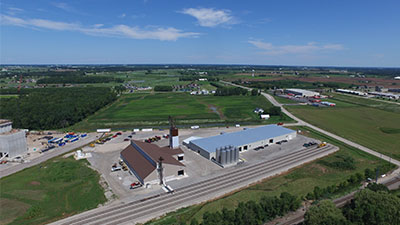Wrightstown Agronomy Video Update
Dec 02, 2021

In Wrightstown, we faced many of the same issues seen across the area. May had good planting conditions that started us on the right track. June was warm which made great weather for dry hay; however, we didn’t see much for rain and it showed on the no-till ground and with residual herbicide action. Moving into July, phytophthora and fusarium wilt was the talk in soybeans when we received some larger rains. We had a lot of hazy days for wheat harvest from wild fires, but it didn’t seem to affect yields on crops like soybeans. August was met with two more large rain events and we found white mold in soybean fields that had looked good the entire summer. The end of August brought tar spot, gray leaf spot, and northern corn leaf blight into the corn fields. Tar spot arrived late, but didn’t impact our crop too much. In September, we had warm temps and sunny days for harvesting 5th crop, corn silage, and early soybeans. We also had a big jump start on winter wheat planting that carried into October.
Moving into the winter months, planning for 2022 earlier than normal may be advantageous. Consider sitting down with your agronomist to go over new boundaries, ditches that aren’t supposed to be sprayed, terminating cover crops, and going over standard inputs.
In the video above, we wanted you to see how we prepare, load, and apply the products that help you grow your crops. We have clips of dry spreading section control and sprayer section control. Section control allows us to save grass waterways, use less overall product that cuts back on the overlap, and make sure products are applied where they need to be.
Some things that helped us being more efficient this year was having sprayers share RTK boundaries which saved the applicator time by not having to outline ditches that needed to be saved. RTK is a paid satellite service that is accurate down to the nearest inches compared to the free satellite that can be 2-3 feet off the next time you go to the field. Other things we have been using is Agsync for dispatching the work that needs to be done. Agsync is a software program that displays products applied, their rates and densities, field maps, and directions to the field.
Moving into the winter months, planning for 2022 earlier than normal may be advantageous. Consider sitting down with your agronomist to go over new boundaries, ditches that aren’t supposed to be sprayed, terminating cover crops, and going over standard inputs.
In the video above, we wanted you to see how we prepare, load, and apply the products that help you grow your crops. We have clips of dry spreading section control and sprayer section control. Section control allows us to save grass waterways, use less overall product that cuts back on the overlap, and make sure products are applied where they need to be.
Some things that helped us being more efficient this year was having sprayers share RTK boundaries which saved the applicator time by not having to outline ditches that needed to be saved. RTK is a paid satellite service that is accurate down to the nearest inches compared to the free satellite that can be 2-3 feet off the next time you go to the field. Other things we have been using is Agsync for dispatching the work that needs to be done. Agsync is a software program that displays products applied, their rates and densities, field maps, and directions to the field.